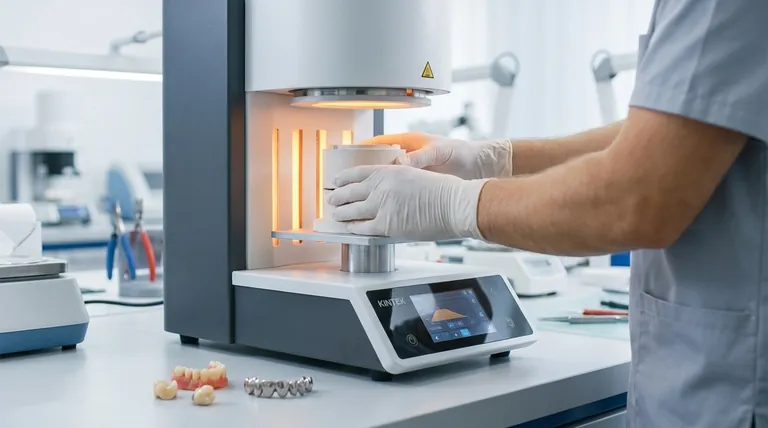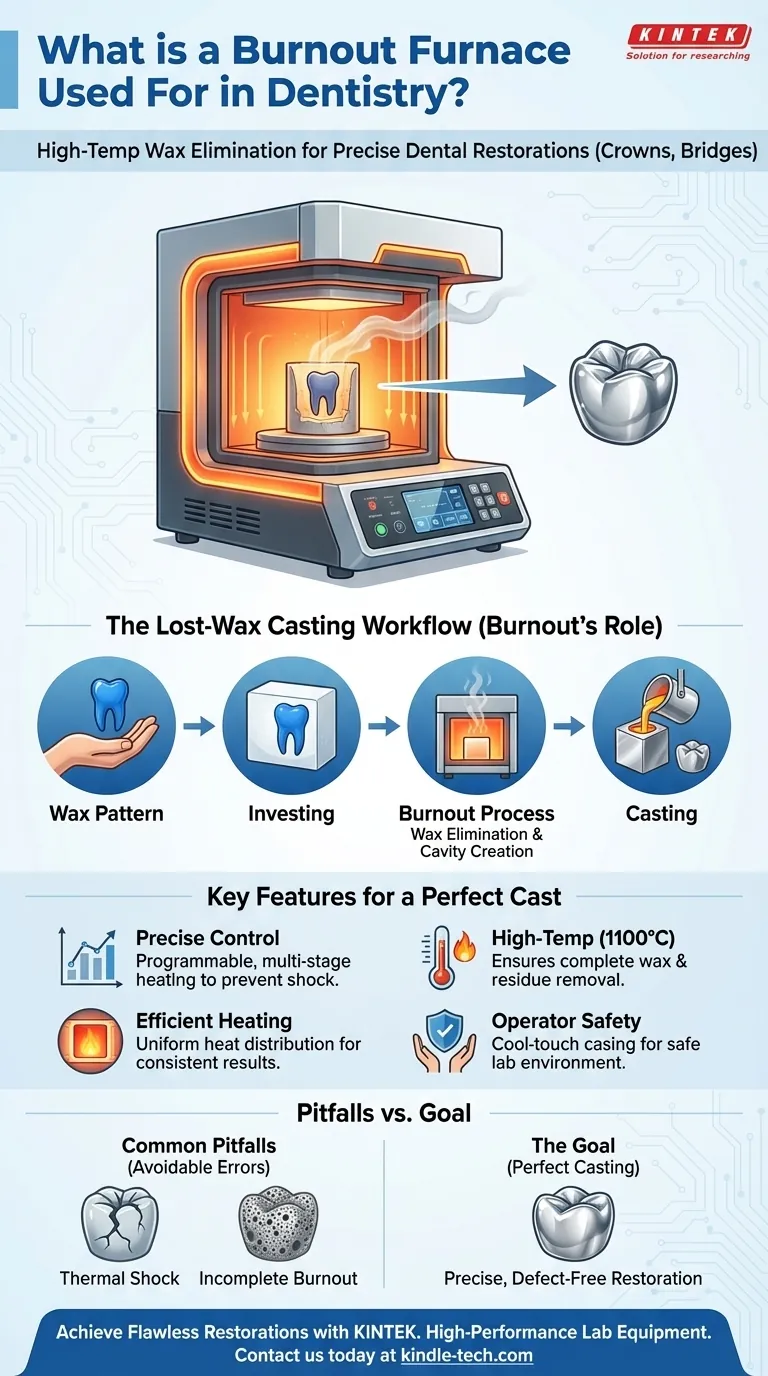In dentistry, a burnout furnace is a specialized, high-temperature oven used to eliminate a wax pattern from a heat-resistant mold. This process, known as "burnout," creates a precise, hollow cavity within the mold. This cavity then serves as the negative space into which molten metal or pressable ceramic is cast to create a final dental restoration like a crown, bridge, or denture framework.
The core function of a burnout furnace is not merely to heat something, but to flawlessly execute the critical "wax elimination" stage of the lost-wax casting technique. It transforms a physical wax model into a perfect negative space within a mold, preparing it for casting the final, durable restoration.

The Role of the Burnout Furnace in Lost-Wax Casting
The burnout furnace is an indispensable tool in a multi-step process known as lost-wax casting. Understanding this workflow clarifies the furnace's exact purpose.
Step 1: Creating the Wax Pattern
First, a dental technician meticulously sculpts the final restoration (e.g., a crown) out of a special type of wax. This wax pattern is an exact replica of the desired outcome.
Step 2: Investing the Pattern
The wax pattern is then encased in a plaster-like, heat-resistant material called investment. Once the investment hardens, it forms a solid block, or mold, with the wax pattern trapped inside.
Step 3: The Burnout Process (Wax Elimination)
This is the critical stage where the furnace is used. The investment mold is placed inside the burnout furnace, which then follows a very specific, pre-programmed heating cycle.
As the temperature slowly rises, the wax first melts and then completely vaporizes, or "burns out." The slow, controlled heating is essential to allow the wax and gases to escape without cracking the delicate investment mold.
Step 4: Casting the Final Restoration
The result of the burnout process is a hardened investment mold containing a perfectly hollow cavity that is an exact negative of the original wax pattern. Molten alloy is then forced into this cavity, filling it completely.
Once cooled, the investment is broken away, revealing a metal restoration that is a precise copy of the initial wax design.
Key Characteristics of a Modern Burnout Furnace
The features of a burnout furnace are directly tied to the demands of the lost-wax technique, where precision and reliability are paramount.
Precise Temperature Control
Modern furnaces offer multi-stage programmable control, often with 30 or more segments. This allows technicians to create custom heating schedules that slowly ramp up, hold, and then increase temperature as required by the specific wax and investment materials being used.
High-Temperature Capability
These furnaces must reach temperatures up to 1100°C to ensure that every last trace of the wax and any organic residue is completely eliminated from the mold.
Efficient Heating and Insulation
Most high-quality furnaces use a ceramic fiber furnace chamber. This material heats up quickly, distributes heat evenly, and saves energy, ensuring the entire investment mold reaches the target temperature uniformly.
Operator Safety
Features like a double-layer steel casing with fan cooling are crucial. This design keeps the exterior surface of the furnace below 50°C, protecting operators from severe burns in a busy lab environment.
Common Pitfalls and Critical Factors
A successful burnout cycle is essential for a successful final casting. Errors at this stage are common and costly.
The Risk of Incomplete Burnout
If the furnace cycle is too short or the temperature is too low, residual carbon from the wax can be left inside the mold cavity. This residue can lead to porosity or surface defects in the final metal casting.
The Danger of Thermal Shock
Heating the investment mold too quickly can cause it to crack or fracture. This phenomenon, known as thermal shock, will ruin the mold and require the entire process to be restarted from the beginning. This is why multi-stage programmability is a critical feature.
Material Compatibility
Different investment materials expand at different rates, and various casting alloys have unique requirements. The burnout cycle must be precisely matched to the manufacturer's specifications for the materials being used to ensure the final casting fits perfectly.
Making the Right Choice for a Perfect Cast
The goal of the burnout process is to create a perfect negative space for casting. Your focus should determine which furnace features you prioritize.
- If your primary focus is accuracy: Prioritize a furnace with highly programmable, multi-stage controls to precisely follow the heating schedules for your specific investment and wax materials.
- If your primary focus is efficiency: Look for a furnace with a ceramic fiber chamber that offers rapid and even heating, reducing the overall cycle time without compromising results.
- If your primary focus is safety: Ensure the equipment has robust safety features like cool-touch external casings and reliable temperature regulation to protect lab personnel.
Ultimately, the burnout furnace is the silent partner that enables the transformation of a delicate wax model into a durable and precise final restoration.
Summary Table:
| Key Feature | Purpose in Dentistry |
|---|---|
| Precise Temperature Control | Ensures complete wax elimination without cracking the mold |
| High-Temperature Capability (up to 1100°C) | Removes all wax/organic residue for defect-free castings |
| Programmable Multi-Stage Cycles | Prevents thermal shock and matches material specifications |
| Ceramic Fiber Chamber | Provides even, efficient heating for consistent results |
| Cool-Touch Safety Casing | Protects operators in busy lab environments |
Ready to achieve flawless dental restorations with a reliable burnout furnace?
KINTEK specializes in high-performance lab equipment for dental laboratories. Our burnout furnaces feature precise programmable controls, superior safety designs, and rapid heating technology to ensure perfect crowns, bridges, and frameworks every time.
Contact us today to find the ideal burnout furnace for your dental lab's accuracy, efficiency, and safety needs!
Visual Guide

Related Products
- Dental Porcelain Zirconia Sintering Ceramic Furnace Chairside with Transformer
- High Temperature Muffle Oven Furnace for Laboratory Debinding and Pre Sintering
- 1800℃ Muffle Oven Furnace for Laboratory
- Laboratory Muffle Oven Furnace Bottom Lifting Muffle Furnace
- 1400℃ Laboratory Quartz Tube Furnace with Alumina Tube Tubular Furnace
People Also Ask
- What is the temperature of sintering zirconia? Mastering the Protocol for Perfect Dental Restorations
- What makes zirconia translucent? The Science Behind Modern Dental Aesthetics
- What are the white spots on zirconia after sintering? A Guide to Diagnosing and Preventing Defects
- What is one of the newest applications for dental ceramics? Monolithic Zirconia for Full-Arch Bridges
- What is the price of zirconia sintering furnace? Invest in Precision, Not Just a Price Tag



















